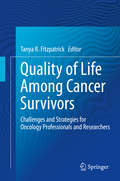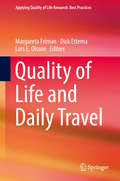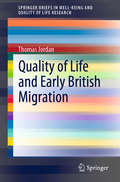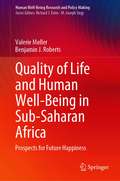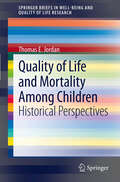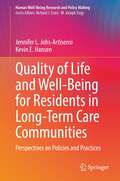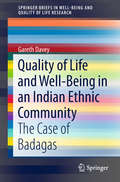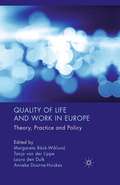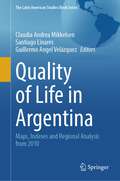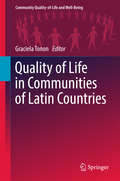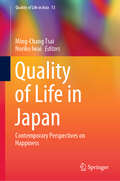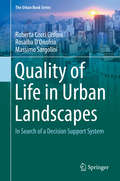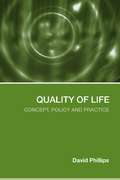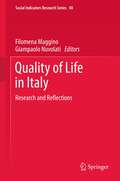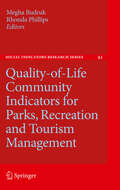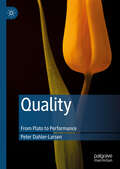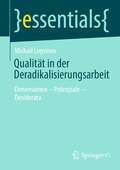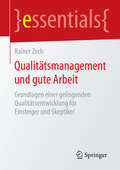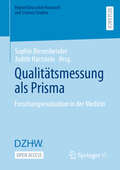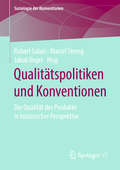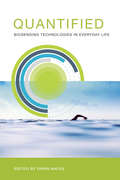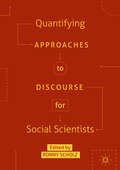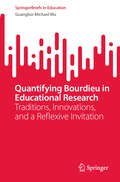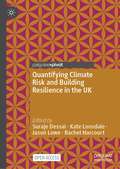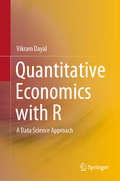- Table View
- List View
Quality of Life Among Cancer Survivors
by Tanya R. FitzpatrickThis multidisciplinary reference explores the concepts and realities of quality of life among cancer survivors in its physical, psychological, cognitive, social, and familial dimensions. Informed by a broad range of fields including genetics, psychiatry, nursing, dentistry, rehabilitation, and ethics, it addresses daily challenges of living for this population, from self-care to cultural concerns and from social interactions to experiences with providers. Family issues of pediatric, young adult, and elder survivors, caregiving parents, and siblings are a major area of concern. And contributors describe interventions for survivors as individuals, in family content, and as part of integrated care across primary and specialty settings. Included among the topics: Play, leisure activities, and cognitive health among older cancer survivors. Genetic mutations in cancer susceptibility genes: a family history of cancer. Cancer patients in a pediatric intensive care unit: a single center experience. The impact of childhood cancer on the quality of life among healthy siblings. When cancer returns: family caregivers and the hospice team. Experiencing cancer services: a story of survival and dissatisfaction. A significant addition to the cancer survivorship literature, Quality of Life Among Cancer Survivors is a practice-building resource for oncology and allied health professionals, health psychologists, and social workers, as well as researchers in these fields.
Quality of Life and Daily Travel (Applying Quality Of Life Research Ser.)
by Dick Ettema Margareta Friman Lars E. OlssonThis volume analyses the relevance of daily travel in the quality of life of individuals. It provides a broad understanding of the links between life satisfaction, well-being and travel, the importance of commuting, and different evaluations and measures to assess the experience of commuting and quality of life. Chapters in this book relate travel and quality of life to the built environment, accessibility and exclusion, travel mode choice, travel satisfaction and emotions. It brings together distinguished researchers from a variety of academic backgrounds providing conceptualizations and applications, presented as case studies, for daily travel and well-being. Findings presented in this book are highly relevant for transport planners, transport marketers, public transport authorities, and environmental professionals in the pursuit of improving people’s life.
Quality of Life and Early British Migration (SpringerBriefs in Well-Being and Quality of Life Research)
by Thomas JordanThis book discusses the quality of life of early modern Britons emigrating to the New World, which became possible with advances in shipbuilding and long-distance sailing. It examines the status and quality of life of those crossing the Atlantic Ocean under legal contract, the indenture – largely to the Carolinas and the communities adjoining Chesapeake Bay in the USA in the 17th century, and also describes and numerically estimates the quality of life among Britons sentenced to “transportation beyond the seas,” who were transported to Australia in the mid-19th century. The author examines the experience of migrants, both adults and children, traveling to the New World and their fate, drawing on documentary sources like state historical records as well as self-documentation from the few surviving diaries. The book also creates profiles of the quality of life of emigrants by gender and age and places the processes of emigration in the social–political contexts of the 17th and 19th centuries.By considering ways in which aspects of social life were organized in eras before structural inquiry into the quality of life, the book provides interesting historical perspectives as well as methodological insights. It appeals to researchers and students interested in the quality of life and wellbeing, and in the history of modern Europe, particularly of the British Empire.
Quality of Life and Human Well-Being in Sub-Saharan Africa: Prospects for Future Happiness (Human Well-Being Research and Policy Making)
by Valerie Møller Benjamin J. RobertsThis volume presents an account of how people in sub-Saharan Africa have fared under changing life circumstances of the past centuries until the present. By introducing the geography of the region it traces a time line of different historical periods that have shaped livelihoods of ordinary people of the region, and addresses the major milestones in political and economic development. It focuses on social indicators pointing to significant changes that have affected the health, education and wealth of sub-Saharan Africans and their outlook on the future since the wind of change blew through the region. With case studies and vignettes the book highlights how individual citizens across the 44 different countries of sub-Saharan Africa experience well-being and express their aspirations for the future. This book provides relevant material for practitioners and policy makers, including community and development workers, in non-governmental and other organizations in sub-Saharan African countries.
Quality of Life and Mortality Among Children
by Thomas E. JordanThis birefs examines mortality among young children in the period from the seventeenth to the nineteenth century. It does so using several types and sources of information from the census unit England and Wales, and from Ireland. The sources of information used in this study include memoirs, diaries, poems, church records and numerical accounts. They offer descriptions of the quality of life and child mortality over the three centuries under study. Additional sources for the nineteenth century are two census-derived numerical indexes of the quality of life. They are the VICQUAL index for England and Wales, and the QUALEIRE index for Ireland. Statistical procedures have been applied to the numbers provided by the sources with the aim to identify effects of and associations between such variables as gender, age, and social background. The briefs examines the results to consider the impact of children's deaths upon parents and families, and concludes that there are differences and continuities across the centuries.
Quality of Life and Well-Being for Residents in Long-Term Care Communities: Perspectives on Policies and Practices (Human Well-Being Research and Policy Making)
by Kevin E. Hansen Jennifer L. Johs-ArtisensiThis book explores key factors long-term care recipients have identified as impacting their quality of life and offers programmatic and policy recommendations to enhance well-being within long-term care communities. Leadership and staff who work in nursing homes and other residential care communities serve as gatekeepers to resident well-being, often without recognizing how residents’ quality of life is impacted by their decision-making. This book takes a life domain approach to build on research-based studies that document key drivers of care recipients’ quality of life, including relationships, autonomy and respect, activities and meals, environment, and care. Using a framework that enhances understanding of resident quality of life, it outlines practical, programmatic, and policy suggestions for long-term care stakeholders, such as administrators, managers, front-line staff, family members, and policy-makers, whose directives and actions impact the lived experience of long-term care residents. As such, this book serves as a roadmap for leaders and managers of long-term care communities, along with policymakers who regulate health and human services, to best structure care environments to maximize quality of life and well-being for long-term care recipients.
Quality of Life and Well-Being in an Indian Ethnic Community: The Case Of Badagas (SpringerBriefs in Well-Being and Quality of Life Research)
by Gareth DaveyThis book explores the quality of life among Badagas, an ethnic minority group in South India, as they navigate a society in flux, with specific reference to rural-to-urban migration and new media. At an empirical level, it reveals how Badagas understand themselves and the multifaceted changes in their culture and daily lives, exploring a pertinent concern at the forefront of debate about the future from a global perspective. The book draws attention to the fact that people are adopting flexible identities and lifestyles in an attempt to survive and thrive in a changing India and world, a new ‘Indian-ness’ shaped at the local level. It offers a timely update on previous research on Badagas, which dates to the 1990s, and also serves as an important case study on people’s experiences of the social and economic transformation of Indian society as they become accustomed to new ideas, products, and ways of life. As such, it is a must-read for all those interested in quality of life in India and developing societies.
Quality of Life and Work in Europe: Theory, Practice and Policy
by Tanja van der Lippe Laura Den Dulk M. Bäck-Wiklund T. Van Lippe L. Den Dulk A. Doorne-HuiskesIntense globalization, rapidly changing workplaces and family patterns have renewed the international interest in quality of life. This book examines different institutional arrangements, work-place conditions and gendered work and care that affect the conditions for achieving quality of work and life in European countries.
Quality of Life in Argentina: Maps, Indexes and Regional Analysis from 2010 (The Latin American Studies Book Series)
by Claudia Andrea Mikkelsen Guillermo Angel Velázquez Santiago LinaresThis book studies inequalities in the quality of life of the Argentine population at the regional level. It considers the six regions of the National Statistical System: Northwest, Northeast, Cuyo, Pampa, Metropolitan, and Patagonia. A series of thematic maps is provided and interpreted, which are related to: a. socioeconomic issues (education, health, housing) and b. environmental aspects (environmental problems and recreational resources). These dimensions (socioeconomic and environmental) are integrated into quality of life indexes that allow the comparison of the situation of the population residing in any region of the national territory.
Quality of Life in Communities of Latin Countries
by Graciela TononThis book presents a reconfiguration of the concepts of community in Latin countries as well as the community quality of life and well-being of different groups: children, young people, older adults, migrants. The traditional concept of community has changed together with the way people participate in community spaces. Community nowadays is more than a geographic concentration; it is related to social support, inter-subjectivity, participation, consensus, common beliefs, joint effort aiming at a major objective, and intense and extensive relationships. This volume presents unique experiences about culture, social development, health, water, armed conflicts, the digital media, and sports within communities, written by authors from Latin countries. This volume is a valuable resource for researchers, students, and policy makers in quality of life studies.
Quality of Life in Japan: Contemporary Perspectives on Happiness (Quality of Life in Asia #13)
by Ming-Chang Tsai Noriko IwaiThis edited volume approaches the life experiences and well-being of Japanese people from an empirical perspective. It explores the current trend of happiness among Japanese over time and examines the association of income, lifestyle, and perceived life conditions using modern econometric models with supplementary qualitative observations. Issues relating to ageing, gender, household division of labour, and emigration are also examined to provide a wide scope of results based on both survey and field methods for culturally sensitive researchers. Going beyond the conventional cultural interpretation of the uniqueness of the Japanese case, this book provides timely, empirical evidence for understanding how the various social groups comprising the Japanese population have enjoyed a better quality of life, while some groups are very dissatisfied with social arrangements and have elected to emigrate. The book is a pioneering endeavour to reveal the detailed structure of quality of life and well-being in Japanese society.
Quality of Life in Urban Landscapes: In Search of a Decision Support System (The Urban Book Series)
by Roberta Cocci Grifoni Rosalba D'Onofrio Massimo SargoliniThis volume introduces an innovative tool for the development of sustainable cities and the promotion of the quality of life of city inhabitants. It presents a decision-support system to orient public administrations in identifying development scenarios for sustainable urban and territorial transformations. The authors have split the volume into five parts, which respectively describe the theoretical basis of the book, the policies in question and indicators that influence them, the decision-support system that connects indicators to policies, the case study of Ancona, Italy, and potential future directions for this work. This volume is based on transdisciplinary research completed in May 2016 that involved about 40 researchers at The University of Camerino, Italy and other European universities. With purchase of this book, readers will also have access to Electronic Supplementary Material that contains a database with groups of indicators of assessment of urban quality of life and a toolkit containing the data processing system and management information system used in the book’s case study.
Quality of Life: Concept, Policy and Practice
by David PhillipsQuality of life is one of the most important issues facing the world today and is central to the development of social policy. This innovative book discusses this crucial topic, assessing the criteria for judging attempts to raise quality of life, including the satisfaction of basic and social needs, autonomy to enjoy life and social connectivity. It considers key topics such as: individual well-being and health-related quality of life human needs - living fulfilling and flourishing lives poverty and social exclusion social solidarity, altruism and trust within communities. Quality of Life is the first systematic presentation of this subject from both individual and collective perspectives. It provides a powerful overview of a concept which is becoming increasingly prominent in the social sciences and is essential reading for students of social policy, sociology and health studies.
Quality of life in Italy
by Filomena Maggino Giampaolo NuvolatiThe outcome of the first Italian National Conference on Quality of Life, this volume is full of cogent analysis of topics and issues related to well being and quality of life, including focused papers on specific population groupings and discrete themes. Held in Florence in September 2010, the conference saw the creation of the Italian Association of Quality of Life Studies, devised as a forum for this varied field of research with a rapidly expanding profile in the context of the continuing financial crisis. The papers address a number of recognized quality-of-life concerns, including public health, wealth distribution, employment, political participation and the perception of crime. Contributors deploy innovative methods of analyzing official statistics that result in more complex and multidimensional indicators. Some papers provide data on other European nations that allow for comparative assessment, while others set out fresh approaches to evaluating quality of life itself. Highly relevant not just to academics, but to policy makers and practitioners in a range of sectors, this publication explores important aspects of a crucial contemporary subject.
Quality-of-Life Community Indicators for Parks, Recreation and Tourism Management
by Rhonda Phillips Megha BudrukWhile community quality-of-life indicators are gaining much needed attention in both scholarly work and practice, their application in the areas of parks, recreation and tourism management are not as well known. The applicability of indicator systems for natural resource and natural resource area management within the parks and recreation arena is very high, including urban parks and recreation programs and their influence on quality of life. Tourism is also an area that needs much more work in terms of assessing impacts as well as developing indicators for gauging progress in the long term. All three areas are an integrated discipline and most programs throughout the developed world are housed co-jointly. There are several researchers across the globe who are conducting innovative work in these areas. The editors feel that a volume on the topic will spur additional interests as well as serve to lead the research efforts.
Quality: From Plato to Performance
by Peter Dahler-LarsenThe notion of quality features prominently in contemporary discourse. Numerous ratings, rankings, metrics, auditing, accreditation, benchmarking, smileys, reviews, and international comparisons are all used regularly to capture quality. This book paves the way in exploring the socio-political implications of evaluative statements, with a specific focus on the contribution of the concept of quality to these processes. Drawing on perspectives from the history of ideas, sociology, political science and public management, Dahler-Larsen asks what is the role of quality, and more specifically quality inscriptions, such as measurement? What do they accomplish? And finally, as a consequence of all this, does the term quality make it possible to deal with public issues in a way that lives up to democratic standards? This cross-disciplinary book will be of interest to scholars and students across various fields, including sociology, social epistemology, political science, public policy, and evaluation.
Qualität in der Deradikalisierungsarbeit: Dimensionen – Potenziale – Desiderata (essentials)
by Michail LogvinovDieses essential behandelt Potenziale und Handlungsbedarfe der Qualitätsförderung in der Deradikalisierungsarbeit. Durch die Benennung einzelner Qualitätsdimensionen und -kriterien wird ein praxisorientierter Beitrag zu den kontrovers diskutierten Themen Qualität, Wirkung und Effektivität von Maßnahmen geleistet. Als Vergleichsgrundlage fungieren dabei die Qualitätsdebatte in der Sozialen Arbeit, englischsprachige Forschungen zur Effektivität und Leistungsfähigkeit von Non-Profit-Organisationen, die Qualitätssicherung in der Kriminalprävention und die evidenzorientierte Erforschung der Umsetzungsqualität von Resozialisierungsprogrammen. Im Ergebnis wird eine Reihe von Ansätzen, Standards, Indikatoren und Prädiktoren diskutiert, die für die interne Qualitätsentwicklung der Fachpraxis einen Mehrwert ergeben.
Qualitätsmanagement und gute Arbeit: Grundlagen einer gelingenden Qualitätsentwicklung für Einsteiger und Skeptiker (essentials)
by Rainer ZechIn diesem Essential wird das traditionelle Qualitätsmanagement als verdecktherrschaftliches Disziplinarsystem entschlüsselt und die Frage diskutiert, was unter Qualität substanziell zu verstehen ist. Der Autor argumentiert dafür, dass die Qualitätsfrage in den Kontext der großen Thematik eines guten Lebens in einer gerechten Gesellschaft gehört. Zu diesem Zweck wird sowohl das Gute als auch das Gerechte kurz skizziert. Daraus werden die Voraussetzungen einer entsprechend gelingenden Qualitätsentwicklung abgeleitet, um schließlich beispielhaft für den Bereich der personenbezogenen sozialen Dienstleistungen ein Qualitätsentwicklungssystem vorzustellen, das den Fallen der Disziplinierung entgeht und die Entscheidung über die Definition guter Arbeit - als Prozess und Ergebnis - in die Hände der Arbeitenden gibt.
Qualitätsmessung als Prisma: Forschungsevaluation in der Medizin (Higher Education Research and Science Studies)
by Sophie Biesenbender Judith HartsteinIn diesem Open-Access-Sammelband werden verschiedene Leistungsdimensionen und Datenzugänge für Abbildung medizinischer Forschung empirisch dargestellt und diskutiert. Leitfragen sind dabei:Wie identifizieren wir Qualität in der medizinischen Forschung?Unter welchen Bedingungen lassen sich medizinische Themen bestmöglich beforschen, um das Patientenwohl und die öffentliche Gesundheit zu fördern sowie Wissenschaft und Gesellschaft voranzubringen?Dieser Logik folgend startet der Sammelband mit Überblicksdarstellungen zum Stand der Evaluation medizinischer Forschung in Deutschland, führt dann auf die eher methodischen, informationswissenschaftlichen Aspekte und empirischen Perspektiven auf die Evaluation medizinischer Forschung und ergänzt diese mit soziologischen Aspekten zur Evaluation medizinischer Forschung als Steuerungsinstrument.
Qualitätspolitiken und Konventionen: Die Qualität der Produkte in historischer Perspektive (Soziologie der Konventionen)
by Robert Salais Marcel Streng Jakob VogelDie wirtschaftswissenschaftliche Standardtheorie interessiert sich selten für etwas anderes als Preise und Mengen. Die hier versammelten Beiträge behandeln dagegen die Qualität von Produkten und Dienstleistungen als konstitutives Prinzip der ökonomischen Beziehungen aus einer historischen Perspektive. Sie gehen davon aus, dass es ohne eine Konvention zwischen den Marktakteuren über die Qualität der gehandelten Ware gar keinen Markt geben kann. Qualitätskonventionen sind deshalb zentrale Elemente der soziohistorischen Dynamik von Ökonomien, die aus spezifischen sozialenKonstellationen entstehen. Dies macht eine enge Zusammenarbeit von Historikern und Konventionenökonomen notwendig. Heutzutage wird mit den Umweltfragen eine neue Dimension der Produktqualität zentral, die auch eine neue Lektüre der Konventionenökonomie notwendig macht, die sich auf die Unterscheidung von Objekt und Ding stützt.Der InhaltMit Beiträgen von: Robert Salais.- Marcel Streng.- Jakob Vogel.- Anne-Françoise Garçon.- Alexander Engel.- Alain Dewerpe.- Dominique Margairaz.- Philippe Minard.- Alessandro Stanziani.- Vera Hierholzer.- Manuel Schramm.Die HerausgeberProf. Dr. Robert Salais, Ecole Normale Supérieure de Paris Saclay.Dr. Marcel Streng, Historiker und Fachübersetzer, Düsseldorf.Prof. Dr. Jakob Vogel, Centre d’Histoire, Sciences Po Paris / Centre Marc Bloch, Berlin.
Quantified: Biosensing Technologies in Everyday Life
by Dawn NafusWhat is at stake socially, culturally, politically, and economically when we routinely use technology to gather information about our bodies and environments? Today anyone can purchase technology that can track, quantify, and measure the body and its environment. Wearable or portable sensors detect heart rates, glucose levels, steps taken, water quality, genomes, and microbiomes, and turn them into electronic data. Is this phenomenon empowering, or a new form of social control? Who volunteers to enumerate bodily experiences, and who is forced to do so? Who interprets the resulting data? How does all this affect the relationship between medical practice and self care, between scientific and lay knowledge? Quantified examines these and other issues that arise when biosensing technologies become part of everyday life.The book offers a range of perspectives, with views from the social sciences, cultural studies, journalism, industry, and the nonprofit world. The contributors consider data, personhood, and the urge to self-quantify; legal, commercial, and medical issues, including privacy, the outsourcing of medical advice, and self-tracking as a “paraclinical” practice; and technical concerns, including interoperability, sociotechnical calibration, alternative views of data, and new space for design.ContributorsMarc Böhlen, Geoffrey C. Bowker, Sophie Day, Anna de Paula Hanika, Deborah Estrin, Brittany Fiore-Gartland, Dana Greenfield, Judith Gregory, Mette Kragh-Furbo, Celia Lury, Adrian Mackenzie, Rajiv Mehta, Maggie Mort, Dawn Nafus, Gina Neff, Helen Nissenbaum, Heather Patterson, Celia Roberts, Jamie Sherman, Alex Taylor, Gary Wolf
Quantifying Approaches to Discourse for Social Scientists (Postdisciplinary Studies in Discourse)
by Ronny ScholzThis book provides an overview of a range of quantitative methods, presenting a thorough analytical toolbox which will be of practical use to researchers across the social sciences as they face the challenges raised by new technology-driven language practices. The book is driven by a reflexive mind-set which views quantifying methods as complementary rather than in opposition to qualitative methods, and the chapters analyse a multitude of different intra- and extra-textual context levels essential for the understanding of how meaning is (re-)constructed in society. Uniting contributions from a range of national and disciplinary traditions, the chapters in this volume bring together state-of-the-art research from British, Canadian, French, German and Swiss authors representing the fields of Political Science, Sociology, Linguistics, Computer Science and Statistics. It will be of particular interest to discourse analysts, but also to other scholars working in the digital humanities and with big data of any kind.
Quantifying Bourdieu in Educational Research: Traditions, Innovations, and a Reflexive Invitation (SpringerBriefs in Education)
by Guanglun Michael MuThis book revolves around the rationale, urgency, and application of quantifying Bourdieu in educational research. It begins with a succinct revisit to Bourdieu’s methodological pluralism and quantitative program, and a critical review of existing but limited Bourdieusian quantitative educational studies, establishing the theoretical, methodological, and contextual foundations for empirical applications of quantitative methodology in Bourdieusian educational research. The book then presents three examples of such empirical applications as individual chapters, utilising multiple correspondence analysis and social network analysis. These chapters respectively examine social class and educational mobility, teacher resilience and teacher education, and social grouping and social change. The book concludes with a proposal to mobilise a range of 'relational' quantitative methodologies – including factor analysis, cluster analysis, logistic regression, multilevel modelling, and cross-lagged panel model – within a Bourdieusian remit, and extends a reflexive invitation to quantify Bourdieu in educational research.
Quantifying Climate Risk and Building Resilience in the UK
by Jason Lowe Suraje Dessai Kate Lonsdale Rachel HarcourtThis open access book draws together key research from the UK Climate Resilience programme. It focuses on topics central to the programme’s research agenda, including improved characterisation and quantification of climate risks, enhanced understanding of the management of climate risks, and the development and delivery of climate services. Key chapters address the challenges inherent to undertaking resilience research, including how to make the term ‘climate resilience’ usable and useful, co-producing research between academics, policy makers and practitioners, and engaging and communicating outside of academia. This book is unique in providing a concise and accessible overview of the programme’s key lessons, placing the findings into a wider context and it will inform future research, policy and practice agendas.
Quantitative Economics with R: A Data Science Approach
by Vikram DayalThis book provides a contemporary treatment of quantitative economics, with a focus on data science. The book introduces the reader to R and RStudio, and uses expert Hadley Wickham’s tidyverse package for different parts of the data analysis workflow. After a gentle introduction to R code, the reader’s R skills are gradually honed, with the help of “your turn” exercises. At the heart of data science is data, and the book equips the reader to import and wrangle data, (including network data). Very early on, the reader will begin using the popular ggplot2 package for visualizing data, even making basic maps. The use of R in understanding functions, simulating difference equations, and carrying out matrix operations is also covered. The book uses Monte Carlo simulation to understand probability and statistical inference, and the bootstrap is introduced. Causal inference is illuminated using simulation, data graphs, and R code for applications with real economic examples, covering experiments, matching, regression discontinuity, difference-in-difference, and instrumental variables. The interplay of growth related data and models is presented, before the book introduces the reader to time series data analysis with graphs, simulation, and examples. Lastly, two computationally intensive methods—generalized additive models and random forests (an important and versatile machine learning method)—are introduced intuitively with applications. The book will be of great interest to economists—students, teachers, and researchers alike—who want to learn R. It will help economics students gain an intuitive appreciation of applied economics and enjoy engaging with the material actively, while also equipping them with key data science skills.
